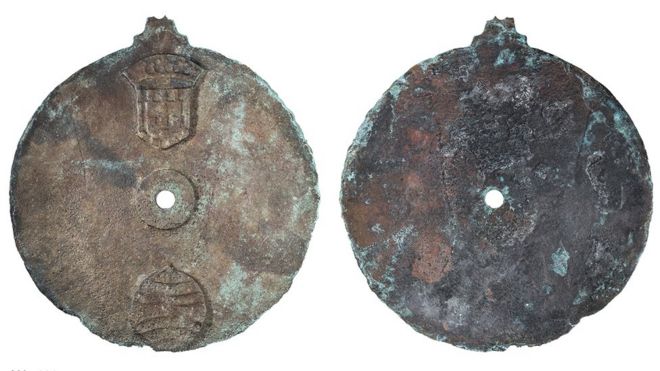 The explorer David Mearns discovered the astrolabe in 2014, one of the almost three thousand artifacts recovered from the Esmeralda that had spent more than 500 years at the bottom of the Indian Ocean, lost to a storm in the Arabian Sea.
The explorer David Mearns discovered the astrolabe in 2014, one of the almost three thousand artifacts recovered from the Esmeralda that had spent more than 500 years at the bottom of the Indian Ocean, lost to a storm in the Arabian Sea.
Marine archaeologists recovered the artifact from what they believed to be the wreck of the Esmeralda, a ship in the Vasco da Gama fleet.
The wreck was located in 1998 and excavated between 2013 and 2015 by a partnership between the Oman Ministry of Heritage and Culture and the shipwreck recovery company Bluewater Recoveries Ltd., which is directed by David Mearns. Support for the project was provided by the National Geographic Society Expeditions Council.
"It's a great privilege to find something so rare, something historically so important, something that will be studied by the archaeological community and that fills a gap," said Mearns.
The Esmeralda is the earliest ship from the Age of Exploration ever to be found and excavated.
The astrolabe, a small bronze disc, 17.5 centimeters in diameter and about two millimeters thick, immediately stood out, "It was not like anything I had seen, and I knew immediately that it was important because I could see two badges."
One was a Portuguese coat of arms and another, he later discovered, was the coat of arms of King Manuel I.
Although Mearns believed that the recovered object was an astrolabe, a navigational instrument used to evaluate the position of the stars and their height above the horizon, an analysis was necessary with the expert help of scientists at the University of Warwick.
Mearns says that the astrolabe had to be manufactured between 1495 and 1500, because D. Manuel only ascended the throne in 1495 and the ship only left Lisbon in 1502.
Astrolabes from this era are rare objects, this is only the 108th to be confirmed, according to the BBC.
The discovery of the Esmeralda was announced by Mearns and the Ministry of Heritage and Culture of Oman last year.
At the time of the announcement of the Esmerelda's discovery, António Camarão, a specialist in underwater archeology, said it had taken two years to study the possible whereabouts of the ships.
The Esmeralda left Portugal in 1502 under the command of Vicente Sodré and was wrecked off the island of Al Hallaniyah as was the São Pedro, commanded by Vicente’s brother , Brás.
"The Sodre commanders were caught up in the storm because of their stubbornness," as they refused to follow Arab advice to go around the east of the island.
The Age of Exploration
The Age of Exploration refers to a period between the mid-15th and 17th centuries when European countries sought out global maritime trade routes. Much of this activity was initially fueled by attempts to reach the spice markets of the Indian subcontinent, which at the time were controlled by the Muslim rulers of Egypt via the Red Sea.
Christopher Columbus' unsuccessful search for a western maritime route to India resulted in the "discovery" of the Americas in 1492, but it was Vasco da Gama who ultimately established the Carreira da India, or India Route, when he sailed around Africa and into the Indian Ocean, landing at Calicut (modern Kozhikode), India in 1498.
A CT scan of the bell revealed the letter 'M' as well as the number '498,' leading researchers to conclude that it is a probable date of 1498, which is chronologically consistent with a ship that left Lisbon in 1502.
In 1502 the king of Portugal, Dom Manuel I (r. 1495-1521) reappointed da Gama as Captain-Major of the fourth Portuguese expedition to India, with a fleet of 20 ships armed with heavy guns to subdue hostile Muslim merchants. Da Gama returned from India to Lisbon in 1503, leaving behind a five-ship squadron led by his uncle Vincente Sodré to protect Portuguese factories along the southwest coast of India. Instead, Vincente Sodré in the Esmeralda, his brother Brás in the São Pedro, and the rest of the squadron sailed to the Gulf of Aden between the Arabian Peninsula and Africa, where the Sodré brothers seized and looted Arab ships.
In May of that year, the squadron was anchored at Al Hallaniyah, one of the Khuriya Muriya Islands off what is now southern Oman, when local residents warned the Portuguese that a dangerous storm was approaching. The Sodré brothers ignored the warning, and according to an eyewitness account their ships were torn from their moorings and dashed against the rocks. The São Pedro was driven ashore and most of its crew survived, while the Esmeralda and its crew perished in deeper waters.
Scholars estimate that out of more than a thousand ships that plied the Carreira da India - at the time the world's longest sea route - between 1498 and 1650, roughly 20 percent of the vessels were lost at sea. However, very few India Route shipwrecks have been found and excavated, and until the discovery in Oman the earliest-known wreck that could be conclusively identified was that of the São João, which foundered off the South African coast in 1552.
























